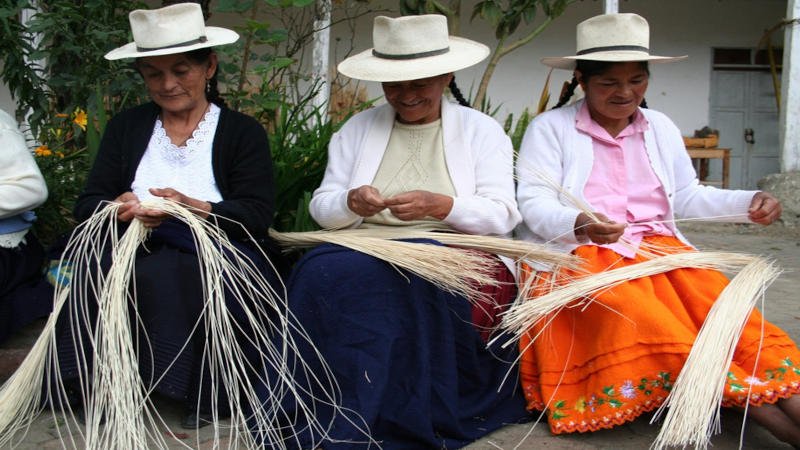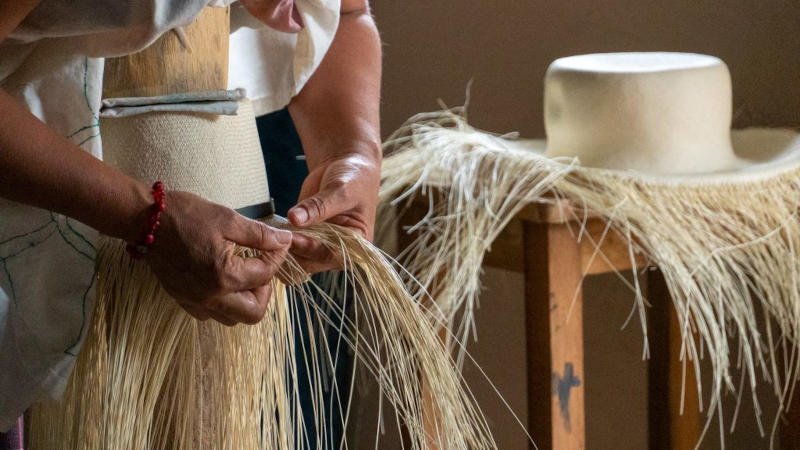
The Panama Hat: A Misnomer Rooted in Ecuadorian Craftsmanship
When one hears “Panama hat,” the mind might conjure images of tropical beaches, Central American trade routes, or perhaps Humphrey Bogart donning a crisp, white brim in a classic film. Yet, the Panama hat’s true story begins not in Panama but in Ecuador, a small South American nation where skilled artisans have woven these lightweight, elegant hats from the toquilla palm for centuries. Far from a mere fashion accessory, the Panama hat embodies a legacy of Indigenous ingenuity, colonial trade, and a curious twist of historical branding that turned an Ecuadorian craft into a global icon. This article delves into the hat’s origins, spotlighting the coastal town of Montecristi—its birthplace—and the highland city of Cuenca, which became its industrial heart, while drawing on insights from Tom Miller’s The Panama Hat Trail.
The Toquilla Straw: Nature’s Gift to Ecuador
The Panama hat’s journey begins with the Carludovica palmata, a palm-like plant native to Ecuador’s coastal regions. Known locally as toquilla, this plant produces long, flexible fronds that, when harvested, stripped, boiled, and dried, yield the fine straw that master weavers transform into hats. Unlike true palms, toquilla thrives in the humid lowlands of Ecuador’s Manabí province, where Montecristi sits as a quiet epicenter of this tradition. The process of preparing the straw is laborious—entire families often participate, from cutting the fronds to splitting them into delicate strands. As Miller describes in The Panama Hat Trail, the sight of Ecuadorian villagers bent over their work, hands deftly handling the straw, is a testament to a craft passed down through generations.

The hats’ earliest iterations predate European colonization, worn by Indigenous peoples as practical protection from the equatorial sun. Lightweight, breathable, and durable, the toquilla hat was ideally suited to the region’s climate. When Spanish conquistadors arrived in the 16th century, they noted the headwear’s utility and adopted it, laying the groundwork for its spread beyond Ecuador’s borders.
Montecristi: The Birthplace of a Legend
Nestled along Ecuador’s Pacific coast, Montecristi is a sleepy town that belies its historical significance. Often overshadowed by its larger neighbor, Guayaquil, Montecristi is where the Panama hat—known locally as sombrero de paja toquilla—earned its reputation for unparalleled quality. Here, in the 19th century, weavers perfected the art of creating fino and superfino hats, distinguished by their tight, almost fabric-like weave. A true superfino can take months to complete, with artisans counting hundreds of straws per inch, their fingers moving with a precision that borders on the miraculous.

Miller’s The Panama Hat Trail paints Montecristi as a place where time seems to stand still, where the rhythm of life revolves around the hat trade. He recounts meeting weavers like Don Victor, a master craftsman whose hands tell the story of decades spent shaping straw into art. These artisans work in humble homes, often seated on dirt floors, their tools little more than their own dexterity and a wooden mold to shape the crown. The finest Montecristi hats are so tightly woven they can hold water—a feat that became a hallmark of their quality.
By the mid-19th century, Montecristi hats were gaining notice beyond Ecuador. Traders exported them to Panama, a bustling hub during the California Gold Rush (1848–1855). American prospectors, passing through Panama en route to the gold fields, purchased these hats for their practicality in the scorching sun. Photographs of these travelers wearing the hats circulated widely, and soon the “Panama hat” name stuck—despite its Ecuadorian origins. The misnomer was cemented in 1906 when President Theodore Roosevelt was photographed wearing one during his visit to the Panama Canal, an image that splashed across newspapers worldwide.
Cuenca: The Industrial Heart of the Panama Hat
While Montecristi gave birth to the Panama hat’s mystique, Cuenca, a colonial city in Ecuador’s Andean highlands, transformed it into a global commodity. By the late 19th and early 20th centuries, Cuenca emerged as the hat’s industrial center, blending traditional weaving with organized production. Unlike Montecristi’s artisanal focus, Cuenca’s hatmakers scaled up to meet growing international demand, establishing workshops and factories that churned out hats by the thousands.

Cuenca’s rise was no accident. The city’s cooler climate and higher elevation made it an appealing base for merchants and entrepreneurs who saw profit in the toquilla trade. Its cobblestone streets and red-tiled roofs, framed by the Andes, housed a growing network of hat finishers—artisans who bleached, blocked, and shaped the woven crowns into their final form. Miller describes Cuenca as a place of contrasts: a city proud of its colonial heritage yet buzzing with the energy of a cottage industry on the cusp of modernity.
The hats produced in Cuenca were often less refined than Montecristi’s superfinos, but their affordability and consistency broadened the Panama hat’s appeal. Exported to Europe, the United States, and beyond, they became a staple of men’s fashion in the early 20th century, worn by everyone from dapper urbanites to plantation owners in the tropics. Cuenca’s hatmakers also innovated, experimenting with styles like the wider-brimmed plantation hat and the sleek fedora, ensuring the Panama hat’s versatility.
The Craftsmanship Divide: Montecristi vs. Cuenca
The distinction between Montecristi and Cuenca hats is more than geographical—it’s a matter of philosophy. Montecristi remains the gold standard for purists, where a single superfino might fetch thousands of dollars today. These hats are labors of love, often made to order by artisans who see their work as a cultural inheritance. In contrast, Cuenca represents accessibility, producing hats that, while still handwoven, cater to a broader market. A Montecristi hat might take three to six months to weave, while a Cuenca hat could be completed in weeks or even days.
Miller’s journey in The Panama Hat Trail highlights this tension. He marvels at the skill of Montecristi’s weavers, yet acknowledges Cuenca’s role in keeping the tradition alive amid economic pressures. The book captures the pride of both regions—Montecristi’s quiet dignity and Cuenca’s industrious spirit—while lamenting the encroachment of mass production and synthetic alternatives that threaten the craft.
A Global Icon with Ecuadorian Roots
The Panama hat’s fame peaked in the early 20th century, but its story is far from over. Hollywood cemented its allure, with stars like Clark Gable and Gregory Peck sporting them on screen. Yet, as fashion shifted and synthetic hats flooded the market, demand for authentic toquilla hats waned. By the late 20th century, Ecuador’s hat industry faced decline, a reality Miller confronts as he traces the trail from rural weavers to urban exporters.

Today, there’s a resurgence of interest in handmade goods, and the Panama hat is reclaiming its place as a symbol of craftsmanship and heritage. Montecristi’s superfinos are collector’s items, while Cuenca’s workshops continue to produce hats for everyday wear. In 2012, UNESCO recognized the traditional weaving of the Ecuadorian toquilla hat as an Intangible Cultural Heritage, affirming its significance beyond mere fashion.
Conclusion: A Hat by Any Other Name
The Panama hat’s journey from Ecuador’s coastal villages to the world stage is a tale of resilience, misadventure, and artistry. Montecristi gave it soul, Cuenca gave it scale, and a twist of fate gave it a name that obscures its true origins. As Tom Miller’s The Panama Hat Trail reveals, behind every hat lies a human story—of hands splitting straw at dawn, of families preserving a craft against the odds, of a nation asserting its identity in a globalized world. So the next time you see a Panama hat, tip it not to Panama, but to Ecuador, where the real trail begins.




